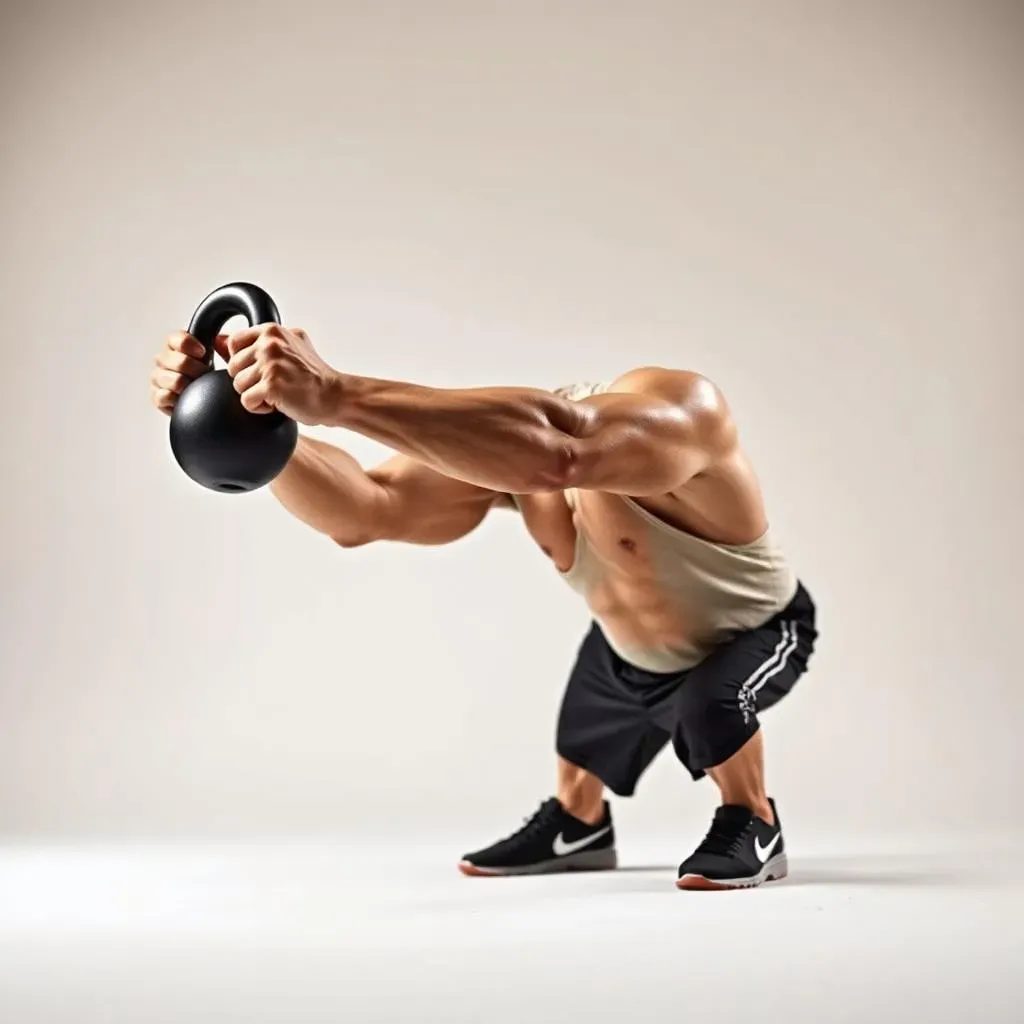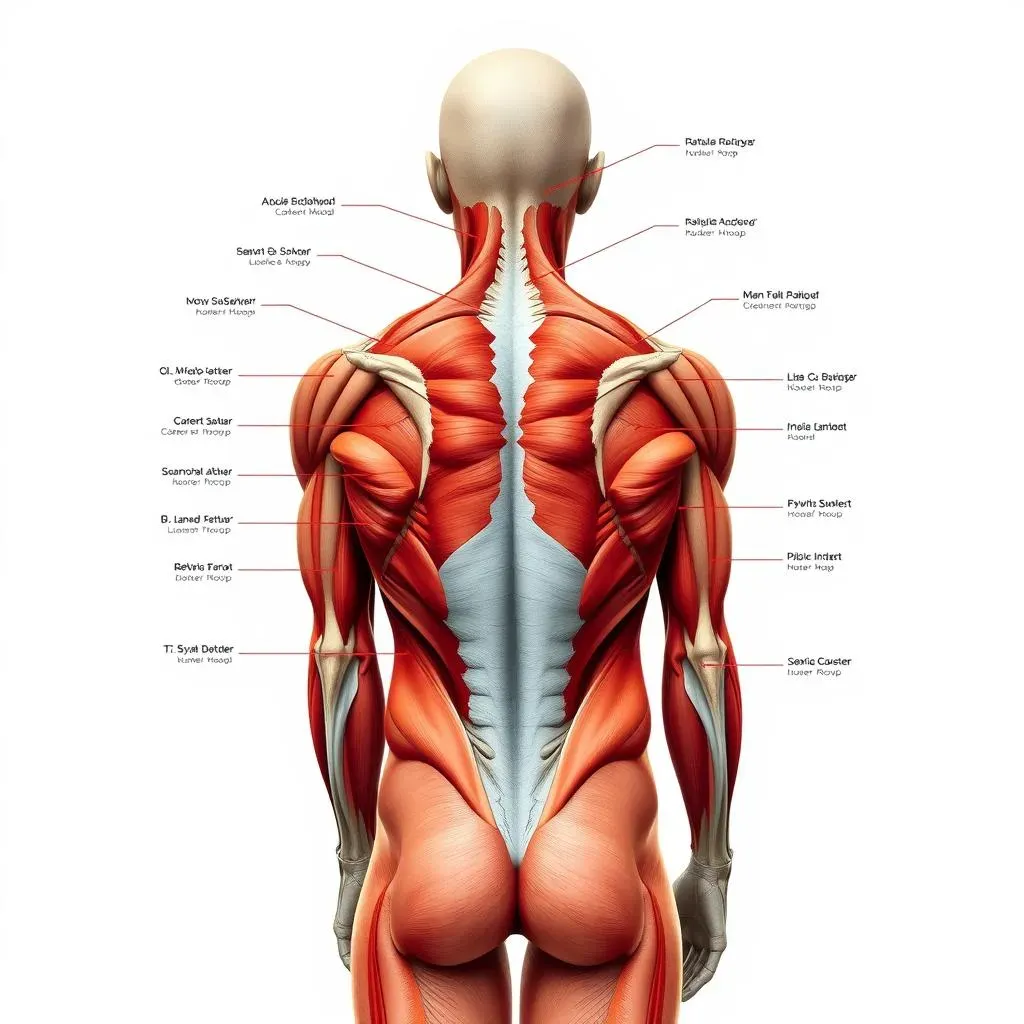Table of Contents
Tired of the same old barbell routine? Ready to unlock a stronger, more resilient back? Then it's time to grab a kettlebell! This isn't just about lifting weights; it’s about building functional strength that translates to everyday life. We're not talking about those clunky gym machines; we are talking about dynamic, full-body movements that'll leave your back feeling powerful and ready for anything. Forget endless pull-ups; kettlebells offer a fantastic way to target your back from all angles, helping you build muscle, improve posture, and even torch some calories. In this article, we'll explore the best kettlebell exercises for your back, how to craft your own effective workouts, and why this method is a total game-changer. So, if you're keen on discovering the secrets to a rock-solid back using back workouts with kettlebell, keep reading – it's time to get started!
Why Kettlebells Are Awesome for Back Workouts

Why Kettlebells Are Awesome for Back Workouts
Functional Strength for Real Life
Let's be honest, most of us don't spend our days bench-pressing cars. We need strength that helps us move better, lift groceries, and avoid back pain from sitting all day. That's where kettlebells shine. They're not just weights; they're tools for building functional strength. Unlike barbells, which often lock you into a fixed path, kettlebells let you move naturally. This means you're not just building muscle; you're also improving your coordination, stability, and mobility—all crucial for a healthy back.
More Than Just a Lift
Think about it: a kettlebell swing isn't just about your arms; it’s a full-body movement that engages your core, glutes, and, you guessed it, your back. This means you are working multiple muscle groups at once, making your workouts more efficient and effective. Because of the unique shape of the kettlebell, you’re also constantly fighting to stabilize the weight, which gives your back muscles a serious workout, all while improving your balance. Plus, the dynamic nature of kettlebell exercises means you're burning more calories and building more muscle compared to traditional weightlifting.
Variety is the Spice of Back Gains
Kettlebells offer a huge range of exercises to target your back from every angle. From rows and swings to deadlifts and carries, you can hit your lower, middle, and upper back muscles all with one tool. This variety keeps your workouts fun and challenging, and it also helps prevent imbalances and plateaus. I mean, who wants to do the same boring exercise every single time? With kettlebells, you can constantly switch things up and keep your back guessing.
Top Kettlebell Exercises for a Powerful Back

Top Kettlebell Exercises for a Powerful Back
Okay, so you're ready to get into the nitty-gritty of top kettlebell exercises for a powerful back? Fantastic! Forget those complicated machines, we are focusing on the moves that actually deliver results. We're talking about exercises that not only build muscle but also enhance your overall body awareness. Think of these moves as your back's new best friends, each targeting different areas to ensure you're hitting all the right spots. Let’s go over the exercises that are going to get your back stronger than ever.
First up, we have the Three-Point Row. This is a fantastic way to target your lats and rhomboids. You’ll plant one hand on a bench or stable surface, keep your back straight, and row the kettlebell up towards your chest. Then there’s the Gorilla Row, a personal favorite. It’s like a row, but you're in a wider stance, which gives you a nice stretch in the lats. Next is the Chest-Supported Row, which as it suggests is done with your chest supported, so you’re isolating your back muscles even more. These rows are not just about pulling; they are about squeezing your shoulder blades together to really engage those muscles.
Exercise | Target Muscles | Why It's Awesome |
|---|---|---|
Three-Point Row | Lats, Rhomboids | Great for building back thickness |
Gorilla Row | Lats, Core | Wider stance, more lat activation |
Chest-Supported Row | Upper back, Rhomboids | Isolates back muscles |
Moving on, we've got the Shrug. Now, shrugs might seem simple, but they're crucial for building those upper back and trap muscles that often get neglected. Then there’s the Renegade Row, which is like a plank with a row, so you get a killer core workout at the same time. The Pullover is next, and it is a great exercise for stretching and engaging your lats. And don’t forget the Iron Cross, an advanced movement that builds serious upper back strength and stability. Finally, we have the Deadlift, the king of all exercises. While it's a full-body move, it's also incredibly effective for building lower back strength. Remember, it's about quality over quantity. Focus on maintaining good form throughout each exercise.
Crafting Your Kettlebell Back Workout Routine

Crafting Your Kettlebell Back Workout Routine
Alright, so now that you know the best exercises, let's talk about putting them together into a solid routine. It's not just about throwing a bunch of exercises together and hoping for the best. You need a plan, a method to the madness. Think of it like baking a cake – you can't just throw all the ingredients in and expect a masterpiece. You need a recipe, right? The same goes for your back workouts with kettlebells. It's about finding the right balance of exercises, sets, reps, and rest periods to get the most out of your training. We want to create a workout that challenges you but also allows your body to recover and grow stronger.
First things first, let's warm up. Don't just jump straight into heavy lifting. You need to get your muscles warm and your joints lubricated. A good dynamic warm-up is key. Think jumping jacks, some T-spine rotations, and a few kettlebell halos to get those shoulders and back ready to rock. This will help prevent injuries and get your body prepared for the work ahead. Then, you want to start with compound movements. These are exercises that work multiple muscle groups at once, like the deadlift and renegade row. These are your bread and butter and should be the foundation of your workout. After that, you can move onto more specific exercises that target those smaller back muscles, like the shrugs and pullovers.
Workout Phase | Example Exercises | Why It's Important |
|---|---|---|
Warm-up | Jumping Jacks, T-Spine Rotations, Kettlebell Halos | Prepares muscles and joints, reduces injury risk |
Compound Movements | Deadlifts, Renegade Rows, Three-Point Rows | Works multiple muscle groups, builds overall strength |
Targeted Exercises | Shrugs, Pullovers, Iron Cross | Focuses on specific back muscles, improves muscle definition |
Now, about sets and reps: there's no magic number, but a good starting point is 3 sets of 8-12 reps for most exercises. If you are new to this, start with the lower end of that range and gradually work your way up as you get stronger. Remember, the key is to maintain good form throughout each rep. It's better to do fewer reps with good form than more reps with bad form. And don't forget about rest! Give yourself about 60-90 seconds of rest between sets, or more if you feel like you need it. Your body needs time to recover, so don't rush it. Listen to your body. If something hurts, stop. It’s better to take a break than to push through pain and risk an injury. The goal is to build a strong back, not to break yourself.
Finally, remember that consistency is key. You won't see results overnight. Aim to do your back workouts with kettlebells 2-3 times per week, with rest days in between. This will allow your muscles to recover and rebuild. It is also important to change your routine every 3-4 weeks. This will prevent you from hitting a plateau and help you continue to make progress. So, mix it up, try new exercises, and don't be afraid to experiment. Most importantly, have fun with it! This is about building a stronger, healthier back, but it should also be something you enjoy doing.
Tips for Safe and Effective Kettlebell Back Training

Tips for Safe and Effective Kettlebell Back Training
Alright, let's talk safety, because nobody wants a tweaked back, right? When you're getting into kettlebell back training, it's super important to focus on form. It's not about how much weight you're swinging, but *how* you're swinging it. Think of it like this: you wouldn't drive a car with your eyes closed, so don't lift a kettlebell with bad form. Start light, get comfortable with the movements, and only increase the weight when you're confident with your technique. This will not only help you avoid injury, but also make sure that you are working the right muscles. Slow and steady wins the race, especially with your back.
Another key thing to remember is to engage your core. Your core is like the foundation of a building; if it's weak, everything else is going to be unstable. So, before you start any kettlebell exercise, brace your core as if you’re about to get punched in the stomach. This will help protect your spine and give you more power. And don't forget about your breathing. Breathe in on the way down, breathe out on the way up. It sounds simple, but it makes a big difference. Proper breathing helps you maintain control and stability, and helps you avoid holding your breath, which can cause problems down the line. Lastly, if you are unsure about any of the exercises or have any pain, it is a good idea to consult a professional. A personal trainer or physical therapist can help you learn the proper techniques and will keep you safe.
Safety Tip | Why It's Important |
|---|---|
Focus on Form | Prevents injury, ensures correct muscle activation |
Engage Your Core | Stabilizes spine, increases power |
Proper Breathing | Maintains control, prevents holding breath |
Start Light | Builds confidence, avoids overexertion |
Consult a Professional | Corrects form, gives personalized advice |
Also, remember that rest and recovery are just as important as the workouts themselves. Your muscles don't grow when you're working out; they grow when you're resting. So, make sure you are getting enough sleep, eating a healthy diet, and giving your body time to recover between your workouts. If you are training hard, you should probably consider taking a day or two off each week so your body can repair itself. And don't be afraid to take it easy on days when you're feeling tired or sore. Pushing yourself too hard can lead to overtraining and injuries, which will set you back. Listen to your body, it knows what it needs. Remember, this is a marathon, not a sprint. So take your time, be smart, and enjoy the journey.
The Benefits of Using Kettlebells for Back Strength

The Benefits of Using Kettlebells for Back Strength
Okay, so we've talked about how to train, but let's get into the "why." Why should you even bother with kettlebells for back strength? Well, let me tell you, the benefits are pretty awesome. First off, we're talking about serious strength gains. Kettlebells aren't like those wimpy dumbbells; they force your body to work harder to stabilize the weight, meaning your back muscles get a serious workout. And it's not just about getting bigger muscles; it's about getting stronger, more functional muscles that help you move better in your daily life. Think about lifting groceries, playing with your kids, or even just sitting at your desk without getting a sore back. All of that gets easier when you have a strong back. And let's not forget about posture. Kettlebell training can do wonders for your posture by strengthening the muscles that keep your spine aligned. No more slouching, you will be standing tall and feeling confident. Also, if you are looking to burn some calories, kettlebell exercises are a great way to do it. They are a full-body workout that gets your heart pumping and helps you torch some fat. So, not only are you building a stronger back, but you are also getting a full-body workout in the process.
Understanding Your Back Muscles: A Quick Guide

Understanding Your Back Muscles: A Quick Guide
The Big Picture
Alright, let's get a little nerdy for a second and talk about the muscles that make up your back. It's not just one big slab of meat back there; it's a complex network of muscles working together to keep you upright and moving. Think of your back like a superhero team, each member with their own special job. You've got the big guys, like the lats, which are like your wings, and the smaller, but equally important, muscles like the rhomboids, that help you pull your shoulder blades together. Knowing what these muscles are and what they do can help you better target them in your workouts and get the most out of your training. It's like having a map of the terrain; you know where to go to get the results you want.
Meet the Team
So, who are these superheroes? First up, we have the trapezius, which runs from your neck down to the middle of your back. These guys are responsible for shrugging and tilting your head. Then there are the latissimus dorsi, or lats, which are those big, broad muscles that give you that V-shape. They help you pull your arms down and back. Next, we have the rhomboid major and minor, which sit between your shoulder blades and are responsible for pulling them together. And lastly, there's the levator scapulae, which helps you lift and rotate your shoulder blades. These are just the main players, there are also smaller muscles that contribute to back function and stability. Understanding each of these muscles and what they are responsible for is key to training your back effectively.
Muscle | Function | Why It's Important |
|---|---|---|
Trapezius | Shrugging, head tilting | Upper back strength, neck stability |
Latissimus Dorsi (Lats) | Pulling arms down and back | Back width, pulling power |
Rhomboid Major & Minor | Pulling shoulder blades together | Posture, upper back stability |
Levator Scapulae | Lifting and rotating shoulder blades | Neck and shoulder movement |
Why This Matters
Now, you might be thinking, "Okay, cool, but why do I need to know all this muscle stuff?" Well, here's the thing: when you understand how your back muscles work, you can train them more effectively. Instead of just doing random exercises, you can choose movements that target specific areas and help you achieve your goals. For example, if you want to build a bigger back, you'll want to focus on exercises that work the lats, like rows and pull-ups. If you want to improve your posture, you'll want to strengthen your rhomboids and traps with exercises like shrugs and rows. This knowledge will also help you to avoid injury. Knowing how your muscles function will help you perform exercises with proper form, which will minimize your risk of pain and injury. So, whether you're looking to build a bodybuilder back or just want to be able to lift groceries without pain, a little understanding of back muscles goes a long way.